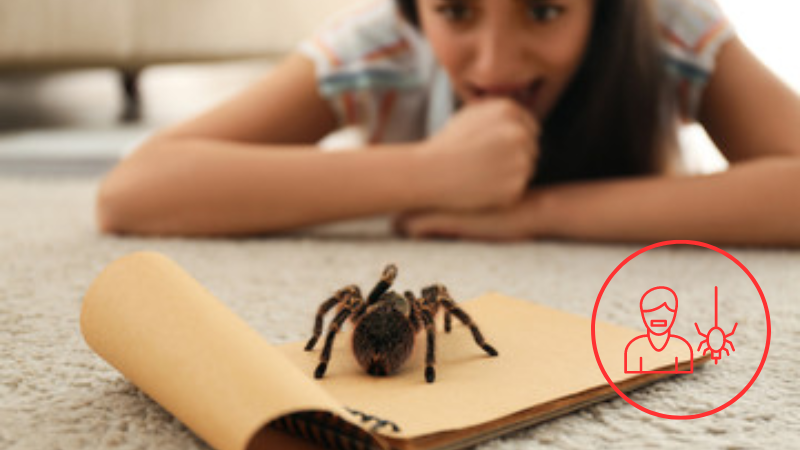Do you tremble at the sight of a spider? If so, you may be experiencing arachnophobia. This intense fear of spiders affects a significant number of individuals. Symptoms can range from rapid heart rate and sweating to even panic attacks. Scientists believe that this fear stems from a combination of genetic and environmental factors. Fortunately, there are various treatment options available to help you overcome your arachnophobia and live a spider-free life.
Definition of Arachnophobia
Arachnophobia is your intense fear of spiders. It is a specific phobia, which means that it is an irrational and excessive fear of a particular object or situation. In this case, the object of fear is spiders. Arachnophobia is a common phobia, affecting a significant portion of the population. It can cause severe distress and anxiety, leading to avoidance behaviors and interference with daily life.
The fear of spiders can manifest in various ways. Some individuals may experience a rapid heart rate, sweating, trembling, and shortness of breath when they encounter a spider or even think about them. Others may feel a sense of dread, panic, or terror in the presence of a spider. The fear may also lead to avoidance of places or activities where spiders are likely to be found, such as gardens, basements, or outdoor activities.
The exact cause of arachnophobia is not fully understood. However, it is believed to be a combination of genetic, environmental, and psychological factors. Some studies suggest that a traumatic experience involving spiders can trigger the development of arachnophobia. Additionally, cultural and societal factors may play a role in shaping individuals’ fears and perceptions of spiders.
Prevalence of Arachnophobia
A significant number of individuals experience arachnophobia, making it a prevalent fear of spiders. Research has shown that arachnophobia affects approximately 3.5 to 6.1 percent of the global population. The fear can manifest in different ways, ranging from mild anxiety to severe panic attacks.
The prevalence of arachnophobia can be influenced by various factors, including cultural and environmental aspects. Some studies suggest that the fear of spiders may be more common in societies where spiders are considered dangerous or associated with negative beliefs. Additionally, individuals who have had traumatic experiences with spiders in the past are more likely to develop arachnophobia.
The prevalence of arachnophobia also varies by gender, with women more commonly affected than men. This gender difference may be attributed to biological and evolutionary factors, such as women’s increased vulnerability to spider bites during pregnancy and childbirth.
Furthermore, arachnophobia tends to develop during childhood or adolescence and can persist into adulthood if not properly addressed. Early exposure to spiders or witnessing others displaying fear towards spiders can contribute to the development of this phobia.
Understanding the prevalence of arachnophobia is crucial for developing effective treatments and interventions to help individuals overcome their fear of spiders.
Symptoms of Arachnophobia
When you have a fear of spiders, known as arachnophobia, you may experience various symptoms that can range from mild discomfort to extreme distress. These symptoms can manifest in both physical and psychological ways. Physically, you may experience an increased heart rate, rapid breathing, sweating, and trembling when you come into contact with spiders or even just the thought of them. Your body may go into a fight-or-flight response, preparing itself to either confront the threat or escape from it. Psychologically, you may feel intense anxiety and fear, often leading to avoidance behaviors. You may go to great lengths to avoid places where spiders are likely to be present, such as dark corners or basements. Additionally, you may have intrusive thoughts about spiders, leading to nightmares or heightened vigilance in your surroundings. These symptoms can significantly impact your daily life, causing distress and interfering with your ability to function normally. It is important to seek professional help if your arachnophobia symptoms are severe and affecting your quality of life.
Causes of Arachnophobia
One possible cause of arachnophobia is exposure to traumatic spider-related events. These events might include being bitten by a spider, witnessing someone else being bitten, or experiencing a spider crawling on your body. Such encounters can create a lasting impression, leading to the development of an intense fear response towards spiders.
The causes of arachnophobia can also be influenced by various psychological and environmental factors.
Psychological factors:
- Genetic predisposition: Some individuals may have a genetic predisposition to developing arachnophobia. Studies have suggested that certain genetic variations may contribute to the development of specific phobias, including arachnophobia.
- Conditioning: Arachnophobia can be learned through classical conditioning. For example, if a person experiences a traumatic event involving a spider, they may associate fear and anxiety with spiders, leading to the development of arachnophobia.
Environmental factors:
- Cultural influences: Cultural beliefs and practices surrounding spiders can contribute to the development of arachnophobia. In some cultures, spiders are associated with danger or malevolence, which can exacerbate fear responses.
- Media exposure: Exposure to movies, TV shows, or news stories depicting spiders in a negative or threatening light can also contribute to the development of arachnophobia.
Understanding the causes of arachnophobia is crucial for developing effective treatment strategies that can help individuals overcome their fear and live a more fulfilling life.
Treatment Options for Arachnophobia
If you have arachnophobia, there are several treatment options available to help you overcome your fear of spiders. These treatment options aim to reduce the anxiety and fear associated with spiders, and help individuals gradually face their fears in a controlled and supportive environment. Here are some common treatment options for arachnophobia:
| Treatment Options | Description |
|---|---|
| Cognitive-Behavioral Therapy (CBT) | CBT is a commonly used therapy for arachnophobia. It involves identifying and challenging negative thoughts and beliefs about spiders, and replacing them with more realistic and positive ones. CBT also includes exposure therapy, where individuals gradually confront their fear of spiders in a safe and controlled manner. |
| Virtual Reality Exposure Therapy (VRET) | VRET uses virtual reality technology to simulate realistic spider encounters. Individuals wear a virtual reality headset and are exposed to spiders in a controlled environment. This allows them to gradually confront and overcome their fear, while feeling safe and supported. |
| Medication | In some cases, medication may be prescribed to help manage the symptoms of arachnophobia. Anti-anxiety medications or beta blockers can help reduce anxiety and physical symptoms associated with fear. It is important to consult with a healthcare professional before considering medication as a treatment option. |
| Support Groups | Joining a support group can provide individuals with a safe and understanding environment to share their experiences and learn coping strategies from others who have overcome their fear of spiders. Support groups can offer emotional support and encouragement throughout the treatment process. |
These treatment options can be used individually or in combination, depending on the severity of the arachnophobia and the individual’s preferences. It is important to consult with a mental health professional to determine the most suitable treatment plan for overcoming arachnophobia. With the right support and treatment, individuals can gradually overcome their fear of spiders and regain control over their lives.
Read this next:

